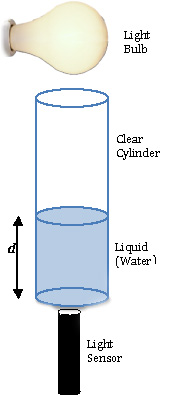Light Absorption by Liquid
 How does light intensity
change as you go below the surface of a liquid like water?
How does light intensity
change as you go below the surface of a liquid like water?Materials
* 60-W Light Bulb
* Clear, Clean Cylinder
* Water w/ food coloring
* Black Construction Paper
* Ruler or Meter Stick
* Light Sensor
* Interface or LabQuest
* Clear, Clean Cylinder
* Water w/ food coloring
* Black Construction Paper
* Ruler or Meter Stick
* Light Sensor
* Interface or LabQuest
Procedure
1. Add food coloring to water so it passes light but is readily visible.2. Mount the cylinder securely using ring stands to hold it in position. Note that the light sensor will need to be directly below it taking measurements, so allowance needs to be made for that. One option would be to place the cylinder on a ring above the light sensor.
3. Position the light bulb above the column and hold it steady with a ring stand or other means.
4. Position the light sensor below the cylinder so it can record the light that passes through the column. Hold it steady with a ring stand and clamp.
5. Cover the sides of the cylinder with black construction paper so the main light source visible to the light sensor will be the light bulb. Extend the construction paper so it covers the space around the light sensor, too, blocking ambient light from the room. Note that you will need to move the paper aside to take measurements periodically, so allowance needs to be made for that, too.
6. With the light bulb turned off, zero the light sensor.
7. Turn the light bulb on and record the light sensor reading and the depth of the water, 0.
8. Add water to the cylinder until it is approximately 5 mL deep. It is not necessary to make the depth precisely 5.0 mL as long as you measure it carefully. Record the light sensor reading and this depth.
9. Continue adding water in approximately 5-cm increments until the cylinder is almost filled, recording your readings along the way.
10. Return the water carefully to the location your instructor indicates. Dry the cylinder and return it and the light sensor and light bulb, also.
Analysis
1. Construct a graph of Light Intensity versus Depth for your water. What general pattern exists for the light that passes through as the column of water increases in depth?2. Conduct an analysis to determine the mathematical pattern between light intensity and depth of the water. Express this in equation form.
3. How does the amount of light passing through twice the depth of water compare to the amount going through a single depth? (Compare 20 cm depth with 10 cm depth.) Is the ratio of light intensities similar to the ratio of depths? Explain.
4. Is there a point at which the amount of light passing through is approximately half the original amount without any water at all? What depth produced this value? Is there similarly a point at which the light intensity dropped to a fourth of its original value? What depth produced this? How do the two values compare?
5. If each group did their own addition of food coloring, how would the results from one group compare with those from another group? Would they be identical? What would be the same and what would be different?
Extensions
1. If you could take measurements as you descended into the ocean, would you expect to see a similar pattern? Explain any similarities and any differences.2. Conduct the Light Filters experiment* where you use colored plastic pieces instead of water. Would you expect similar results in that situation? How might they be different?
Note
I have not given specific instructions that take advantage of features within Logger Pro computer software or the LabQuest app. Certainly using "Events with Entry" would allow students to record their data and graph it with a minimum of effort. Check the instruction manual for how to set up Events with Entry. In Logger Pro there is a file in the Tutorials folder on this feature.* http://cbakkennet.ipage.com/weblabs/filters.html
C. Bakken
July 2012